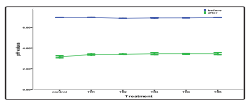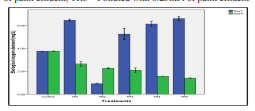Author(s): Orimoloye A M
The paint effluent was collected directly from one paint industry in Lagos from the releasing tank into a sterile bottle, and was transported with the use of ice pack to the laboratory to prevent contamination. Paint effluents contain a complex mixture of chemicals which may have potential threats to biota. The present study was carried out to assess the potential impacts of paint effluents entering the aquatic environment. The concentration of the toxicant was varied into 1.25mls/l, 2.50mls/l, 3.75mls/l, 5.0mls/l and 6.25mls/l into the separate tanks to pollute Claris garipenius. The heavy metals present in the paint effluent were lead (0.34±0.01ppm) and zinc (1.20±0.01 ppm). The volume of water used was 20 litres in the aquaria and concentration of the toxicant was varied into 1.25mls/l, 2.50mls/l, 3.75mls/l, 5.0mls/l and 6.25mls/l into the separate tanks containing the fish. Differences were observed in pH and the BOD5 of the fish water which were monitored for 96hours. There were increases in the fungal population with increase in the treatments of the pollutant. Fungi were isolated from the polluted fish aquaria and parts of the harvested fish. The fungi isolated include; Penicillium italicum, Aspergillus niger, Aureobasidium pullans, Articolospora inflata, Trichosporon sp, Mucor mucedo Rhodotorula rubra Rhizopus stolonifer Candida albicans. The fish water affect the pH, BOD5, fungal loads, fungal types, leads to bioaccumulation of heavy metals in catfish. The overall result of the research requires that care should be taken in discharging the effluent into the water bodies so as to minimise its impact on aquatic organisms.
Population, poverty and pollution are the three major problems of developing countries, including Nigeria [1]. With rapid strides in industrialization of some developing countries, the problem is being further accentuated. Industrial effluents are a main source of direct and often continuous input of pollutants into aquatic ecosystems with long-term implications on ecosystem functioning [2,3]. It is well established that pollution lowers the quality of life in various aspects and affects health and life span [1]. Water contaminated by effluents from various sources is associated with heavy disease burden and this could influence the current shorter life expectancy in the developing countries compared with developed nations [4,5]. Fish are widely used to evaluate the health of aquatic ecosystems [6]. The uptake of heavy metals in fish was found to occur through absorption across the gills surface or through the gut wall trait. Bioaccumulation of heavy metals by fish is not only a danger to the fish accumulating the heavy metals but more importantly great danger is posed to man consuming the fish.
The Clarias gariepinus was obtained from The Federal University of Technology, Akure pond, Obakekere. The fishes were kept in glass aquarium and acclimatised for a period of four weeks. Healthy fishes which showed active movement were only considered for the experiment. The paint effluent was collected directly from a Paint Factory, Agidingbi, Ikeja, Lagos from the releasing tank into a sterile bottle, and was transported with the use of ice pack to the Microbiology laboratory of The Federal University of technology, Akure, Ondo State, for analyses. The setup was for a period of 96hrs using sub-lethal concentrations. The volume of water used was 25 litres in the aquaria and dilution of the toxicant was varied into 1.25ml/l, 2.50ml/l, 3.75ml/l, 5.0ml/l and 6.25ml/l into the separate tanks containing the fish. The aquaria were monitored daily for physiochemical parameters; pH, biochemical oxygen demand while the fungi analyses were monitored daily of fungi loads, isolation and identification of fungi and fungal succession in the polluted fish waters.
| Parameters | Composition |
|---|---|
| Zinc | 0.34±0.01 |
| Nickel | N.D |
| Chromium | N.D |
| Cadmium | N.D |
| Lead | 1.20±0.01 |
Key: ND- Not detected
The heavy metals analysed for were Zinc, Lead, Chromium, Nickel and cadmium and it was only Zinc and Lead (Table 1) that was detectable in part per million (ppm)
| Isolates | Control | Harvested catfish body |
|---|---|---|
| Rhizopus stolonifer | + | + |
| Candida albicans | - | + |
| Rhodotorola rubra | + | + |
| Aspergillus niger | + | + |
| Mucor mucedo | - | + |
| Articolospora inflate | - | + |
| Penicillum italicum | - | + |
| Aureobasidium pullans | + | + |
| Trichosporon sp | - | + |
Table 2 shows a total of nine fungi were isolated from the effluent, the water used, polluted catfish water and harvested catfish parts. The identifications of the fungal isolates in the catfish, were found to be Aspergillus niger, Penicillium italiticum, Rhizopus stolonifer, Actinospora inflata, mucor mucedo, Trichosporon sp, Candida albican, Rhodoturola rubra, Aureobasidium pullans.

Figure 1: Fungal load for catfish (sfu/g)
Fungal counts monitored (figure 1) showed that significant differences in the treatment, at 96hrs of the research there was an increase in the fungal loads
| Treatments | Catfish |
|---|---|
| Control | 5 |
| Tr1 | 9 |
| Tr2 | 13 |
| Tr3 | 15 |
| Tr4 | 10 |
| Tr5 | 4 |
| Total | 56 |
The number of fungi isolated from each pollution treatments showed that the number of fungi isolated increases with decreases in the treatment from Tr4.
| Isolates | Control | Harvested catfish body |
|---|---|---|
| Rhizopus stolonifer | + | + |
| Candida albicans | - | + |
| Rhodotorola rubra | + | + |
| Aspergillus niger | + | + |
| Mucor mucedo | - | + |
| Articolospora inflate | - | + |
| Penicillum italicum | - | + |
| Aureobasidium pullans | + | + |
| Trichosporon sp | - | + |
Key: Control - Not polluted, TR1 - Polluted with 1.25ml/l of paint effluent, TR2 - Polluted with 2.50ml/l of paint effluent, TR3 - Polluted with 3.75ml/l of paint effluent; TR4 - Polluted with 5ml/l of paint effluent, TR5 - Polluted with 6.25ml/l of paint effluent.
| Treatment | Skin | Liver | Gill | Intestine |
|---|---|---|---|---|
| Control | 7.33a±2.52 | 5.00a±3.00 | 11.00a±3.61 | 5.50ab±0.64 |
| TR1 | 5.67a±4.04 | 5.33a±0.59 | 3.67a±3.79 | 11.67b±1.53 |
| TR2 | 5.67a±4.04 | 3.33±2.52 | 3.67b±1.53 | 5.00ab±0.44 |
| TR3 | 6.67a±4.73 | 3.67a±2.08 | 4.67a±3.06 | 3.00a±1.00 |
| TR4 | 5.33a±3.06 | 3.00a±1.00 | 2.67a±0.58 | 4.33a±0.49 |
| TR5 | 5.33a±3.06 | 2.67a±2.08 | 2.00a±1.00 | 6.00ab±2.00 |
Key: Control - Not polluted, TR1 - Polluted with 1.25ml/l of paint effluent, TR2 - Polluted with 2.50ml/l of paint effluent, TR3 - Polluted with 3.75ml/l of paint effluent; TR4 - Polluted with 5ml/l of paint effluent, TR5 - Polluted with 6.25ml/l of paint effluent
| Treatments | Zinc | Lead |
|---|---|---|
| Control | 0.21 | 0.10 |
| TR1 | 0.22 | 0.09 |
| TR2 | 0.24 | 0.08 |
| TR3 | 0.15 | 0.06 |
| TR4 | 0.14 | 0.16 |
| TR5 | 0.22 | 0.15 |
Key: Control - Not polluted, TR1 - Polluted with 1.25ml/l of paint effluent, TR2 - Polluted with 2.50ml/l of paint effluent, TR3 -Polluted with 3.75ml/l of paint effluent; TR4 - Polluted with 5ml/l of paint effluent, TR5 - Polluted with 6.25ml/l of paint effluent

Figure 2: pH of water in catfish aquarium
Key: Control - Not polluted, TR1 - Polluted with 1.25ml/l of paint effluent, TR2 - Polluted with 2.50ml/l of paint effluent, TR3 - Polluted with 3.75ml/l of paint effluent; TR4 - Polluted with 5ml/l of paint effluent, TR5 - Polluted with 6.25ml/l of paint effluent

Figure 3: Biochemical Oxygen Demand in catfish water aquarium
Key: Control - Not polluted, TR1 - Polluted with 1.25ml/l of paint effluent, TR2 - Polluted with 2.50ml/l of paint effluent, TR3 - Polluted with 3.75ml/l of paint effluent; TR4 - Polluted with 5ml/l of paint effluent, TR5 - Polluted with 6.25ml/l of paint effluent
The analytical results show that various contaminants and metals were present in the industrial Paint effluents. The heavy metals analysed for were Zinc, Lead, Chromium, Nickel and cadmium and it was only Zinc and Lead (Table 1) that was detectable in part per million (ppm) in both the paint effluent and the fish tissues. A total of nine fungi were isolated from the effluent, the water used, polluted catfish water and harvested catfish parts. The identifications of the fungal isolates in the catfish, were found to be Aspergillus niger, Penicillium italiticum, Rhizopus stolonifer, Actinospora inflata, mucor mucedo, Trichosporon sp, Candida albican, Rhodoturola rubra, Aureobasidium pullans, (Table 2). Fungal counts monitored (figure 1) showed that significant differences in the treatment, at 96hrs of the research there was a increase in the fungal loads. This could be as the result effluent effect of the pollution on the fungi in the aquatic environment which correlates the findings of Margesin and Schnner, 1997 on the effect of oil pollution on an environment [7]. Fungi isolation and identification were determined before and after a total of 56 fungi from Clarias gariepinus (catfish) aquaria (Table 3). The number of fungi isolated from each pollution treatments showed that the number of fungi isolated increases with decreases in the treatment from Tr4. Fungal counts of the body parts of catfish (Table 4) shows significant differences in each fish body part this could be due to ionization of paint effluent ions in the fish aquaria. The heavy metals composition in the tissues showed that mineral analyses of catfish tissue accumulated zinc and lead (Tables 5). Fish has been reported to accumulate metals from water by diffusion via skin and gills as well as oral consumption [8]. Bioaccumulation of heavy metals in Clarias gariepinus probably might have resulted from inability of the fish to metabolize the heavy metal [9]. The pH (Figures 2) vary significantly (P < 0.05) in the aquaria throughout the study period from 6.96-6.95 for catfish at 24hrs and 3.35-3.40 at 96hrs. pH values for catfish at 24hrs and 96hrsfall below standard of World Health Organization standard of 7.0 to 8.5, this might have been as a result of inorganic material present in the aquaria. The neutral to alkaline pH values obtained at 24hrs is similar to that reported elsewhere [10]. Biological Oxygen Demand (BOD) is the measure of the oxygen required by microorganisms whilst breaking down organic matter (Fig 3) shows the Biochemical Oxygen demand of catfish, Biological Oxygen Demand (BOD) higher values were observed at initial day of catfish. This is undesirable since continuous discharge of effluent has impacted the receiving water body to some extent and this may have negative effects on the quality of the freshwater and subsequently cause harm to the aquatic life especially fish [10].
The discharge of industrial effluents into receiving water bodies in Nigeria invariably result in the presence of high concentrations of pollutant in the water and sediment. The pollutants have been shown to be present in concentrations, which may be toxic to different organisms. The effluents also have considerable negative effects on the water quality of the receiving water bodies. It is therefore recommended that the careless disposal of industrial wastes without pretreatment should be discouraged.
